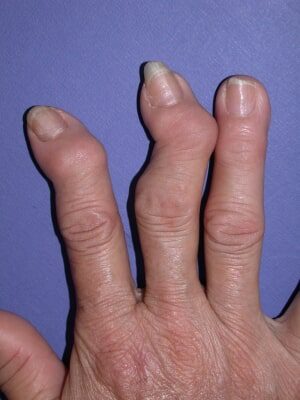Contents
The deformation of the fingers
How do you define deformities of the fingers?
These are unsightly and often annoying deformations of the fingers, which can be characterized by “nodules” in the joints, or by deviations of certain phalanges. These deformities are often associated with pain, and can hinder the mobility of the fingers and hinder daily actions.
What are the causes of deformities of the fingers?
Several conditions can cause deformity of the fingers, in particular osteoarthritis, which can specifically affect the hands.
It is estimated that digital osteoarthritis affects up to 35% of women and 25% of men.
Osteoarthritis most often leads to the formation of nodules in the joints. It evolves in painful outbreaks. Rheumatologists distinguish:
- Heberden’s nodules, which are usually located on either side of the joint, on the posterior surface of the finger. These nodules correspond to a bone deformation;
- Bouchard’s nodules: their location is lateral and they are more painful and more disabling than Heberden’s nodules.
Rheumatoid arthritis is one of the most common causes of deformity of the fingers. This inflammatory rheumatism generally affects several joints, symmetrically, and mainly affects women, sometimes young.
It is estimated that 0,5 to 1% of adults (4 women for 1 man) are affected. Autoimmune in origin, it evolves in flare-ups and is characterized by chronic inflammation. This disease is potentially disabling, since the inflammation can lead to destruction of bones and cartilage and major joint deformities.
Finally, certain traumas to the fingers (dislocations, fractures) that have not been treated or have gone unnoticed can lead to deviations of the affected joints, which heal in a way “askew”.
What are the consequences of deformities of the fingers?
Deformities of the fingers, in addition to being painful, can be extremely disabling. In particular, they prevent certain delicate tasks from being carried out, or from writing or using one’s fingers with sufficient dexterity.
Rheumatoid arthritis, for example, usually starts between the ages of 35 and 45. If it causes deviations of the fingers, it can pose serious professional problems, among others.
In addition, these deformations are unsightly and very visible, since the hands are constantly exposed. For some people, the aesthetic aspect is therefore very difficult to live with.
What are the solutions to counter deformation of the fingers?
It all depends on the origin of the deformations. The idea is to relieve pain, avoid deformities and maintain good mobility of the fingers. In the event of a painful crisis; medical treatment is indicated. It is based on analgesics (paracetamol) and anti-inflammatory creams or by mouth. Cortisone-based infiltrations may be offered in certain cases of very painful outbreaks.
It may also be advisable to wear braces at night. These make it possible to limit the pain, but they are not sufficient to prevent the possible appearance of a deformity.
In case of rheumatoid arthritis, stronger treatments, indicated in cases of autoimmune disease, may be recommended. This is the case with methotrexate, for example. If the inflammation is properly controlled, the deformations will be less.
In cases of osteoarthritis, there are slow-acting drugs such as chondroitin sulphate, avocado and soya unsaponifiables, or diacerrhein, which constitute a basic treatment, but their effectiveness has not been fully demonstrated.
On a daily basis, it is better to avoid carrying heavy loads and “straining” manual activities. Painful joints should be spared. It is possible to keep them warm, using a hot water bottle, to relieve pain.
Finally, rehabilitation based on occupational therapy makes it possible to limit deformities and to learn to continue to use one’s fingers, despite the handicap. It is recommended as soon as the deformities are disabling.
When the pain persists despite everything, the deformity is too unsightly or has lost its mobility, surgical treatment may be considered in certain cases.
Read also :What you need to know about osteoarthritis Our sheet on polyarthritis
|










